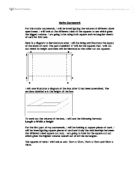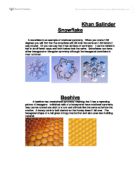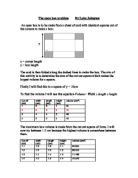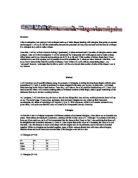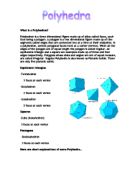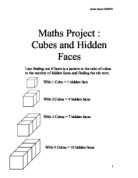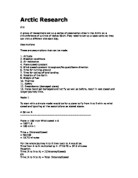Open Box Investigation
25th January Math | Sara Ellis Introduction: The open box problem is regarding an open box made from a sheet of card. Identical sized squares are removed from the four corners of the card (shown in the diagram below). The aim of this investigation is to verify the size of the square removed that would make the largest volume for any given sheet of card, both square and rectangular. I will do this by finding a general formula which would work for finding the best size of square cut. Square Boxes In order to determine the size of square cut off from the card, I tried many different sizes on square boxes to find the size that would give the largest volume. To find the volume I have used the formula: Volume = Length x Width x Height To find the length and width I take two of the length of square cut from the total length/width of the box. The height is the same as the side length of square cut. Below are my results: 0x10 Square Side Length of Square (cm) 2 3 4 Length of Box 8 6 4 2 Width of Box 8 6 4 2 Height 2 3 4 Volume 64 72 48 6 To find the more precise length of square which I should cut, I have used the upper and lower bounds of the best length of square in the table above (in this case, 2cm). Side Length of Square .5 .6 .7 .8 .9 2 2.1 Length of Box 7 6.8 6.6 6.4 6.2 6 5.8 Width of Box 7 6.8 6.6 6.4 6.2 6 5.8
Transformation Patterns. Our aim was to take different 3 digit number patterns and make a pattern that was instructed in the worksheet, and then find a correlation between the pattern of numbers and the line of symmetry and the order of rotation.
TRANSFORMATION INVESTIGATION BY Naman Shah & Aman More Aim: Our aim was to take different 3 digit number patterns and make a pattern that was instructed in the worksheet, and then find a correlation between the pattern of numbers and the line of symmetry and the order of rotation. For example if the number chosen was X,Y,Z then we were first supposed to take a starting point, and facing up the page go x square forward and turn 90 degrees clockwise. Then we were to go y squares forward and turn 90 degrees clockwise and then go z square forward and turn 90 degrees. We were to repeat these instructions until we got the starting point. Methodology: We used the software MSWLOGO to create the shapes using the number patterns and formulae to repeat the pattern. Our formula basically gave the instructions: repeat (move x units forward, then turn 90 degrees, now move y units forward, then again turn 90 degrees, finally move z units forward and turn 90 degrees) 4 times. This caused the pattern to be repeated until the time it got back to the starting point (the small square). Using observation, we found the number of lines of symmetry (if any) for each shape, along with the order of rotation. We used this process on 28 patterns using different combinations of numbers. Note: There were many instances where there was line of symmetry. Patterns: Data table: Pattern Numbers
Maths Coursework
Maths Coursework For this maths coursework, I will be investigating the volume of different sized open boxes. I will look at the different sizes of the squares to see which gives the biggest volume. I am going to be using both square and rectangular sheets of card for this task. Here is a diagram to demonstrate what I will be doing and illustrate the layout of the sheet of card. The parts labelled 'x' will be the squares that I will cut out which its height and sizes will be identical as the other cut out squares. x x x x x x x x I will now illustrate a diagram of the box after it has been assembled. The sections labelled x is the height of the box. To work out the volume of the box, I will use the following formula: Length x Width x Height For the first part of my coursework, I will be looking at square pieces of card. I will be investigating square pieces of card and study the relationships between the different sized square cut outs. I am going to look for the square cut out which gives the highest volume overall out of all the rectangles. The squares of sizes I will look at are: 12cm x 12cm, 15cm x 15cm and 18cm x 18cm. The first square I will look at
Symmetry in Nature
Khan Salinder Snowflake . A snowflake is an example of rotational symmetry. When you rotate it 60 degrees you will find that the snowflake will still look the same as it did before it was rotated. Or you can say that it has six lines of symmetry. It can be folded in half in six different ways and both halves look the same. Snowflakes can have either hexagonal or triangular symmetry although the hexagonal snowflake is most common. Beehive A beehive has translational symmetry meaning that it has a repeating pattern of hexagons. Individual cells of a honeycomb have rotational symmetry they can be rotated one sixth of a turn and still look like the same as before the rotation. A honey comb is built slanted so that honey doesn't fall over. The hexagonal shape of a cell gives strong construction and also uses less building material. Seashell A seashell has reflectional or bilateral symmetry. A seashell only has one line of symmetry. It can be split in half so that one side is like a mirror reflection of the other side. The lines on a seashell are arranged in such a way that you see perfect symmetry. Animal Most animals are symmetrical in at least one way. For animals, symmetry is related to fitness. Symmetrical horses can run faster than non-symmetrical horses. There are two types of animals; radiata and bilateria. Radiata has radial symmetry. Bilateria
Tbe Open Box Problem
The open box problem By Luke Johnston An open box is to be made from a sheet of card with identical squares cut of the corners to make a box: y x = corner length y = box length The card is then folded along the dashed lines to make the box. The aim of this activity is to determine the size of the cut out square which makes the largest volume for a square. Firstly I will find this in a square of y = 10cm To find the volume I will use this equation-Volume= Width x length x height Cut off (cm) width (cm) length (cm) height (cm) volume (cm²) 8 8 64 2 6 6 2 72 3 4 4 3 48 4 2 2 4 6 The maximum box volume is made from the cut out square of 2cms. I will now try between 1-2 cm because the highest volume is somewhere between them. Cut off (cm) width (cm) length (cm) height (cm) volume (cm²) .1 7.8 7.8 .1 66.924 .2 7.6 7.6 .2 69.312 .3 7.4 7.4 .3 71.188 .4 7.2 7.2 .4 72.576 .5 7 7 .5 73.5 .6 6.8 6.8 .6 73.984 .7 6.6 6.6 .7 74.052 .8 6.4 6.4 .8 73.728 .9 6.2 6.2 .9 73.036 2 6 6 2 72 The highest value of x is 1.7, but once again I will find a volume even higher in the 10 by 10 box by going into two decimal places. Cut off (cm) width (cm) length (cm) height (cm) volume (cm²) .61 6.78 6.78 .61 74.0091 .62 6.76 6.76 .62 74.0301 .63 6.74 6.74 .63 74.047 .64 6.72 6.72 .64
GCSE Math Coursework - Shapes Investigation
Summary I this investigation I am going to look at shapes made up of other shapes (starting with triangles, then going on squares and hexagons. I will try to find the relationship between the perimeter (in cm), dots enclosed and the amount of shapes (i.e. triangles etc.) used to make a shape. From this, I will try to find a formula linking P (perimeter), D (dots enclosed) and T (number of triangles used to make a shape). Later on in this investigation T will be substituted for Q (squares) and H (hexagons) used to make a shape. Other letters used in my formulas and equations are X (T, Q or H), and Y (the number of sides a shape has). I have decided not to use S for squares, as it is possible it could be mistaken for 5, when put into a formula. After this, I will try to find a formula that links the number of shapes, P and D that will work with any tessellating shape - my 'universal' formula. I anticipate that for this to work I will have to include that number of sides of the shapes I use in my formula. Method I will first draw out all possible shapes using, for example, 16 triangles, avoiding drawing those shapes with the same properties of T, P and D, as this is pointless (i.e. those arranged in the same way but say, on their side. I will attach these drawings to the front of each section. From this, I will make a list of all possible combinations of P, D and T (or later
Regular Polyhedra
What is a Polyhedron? Polyhedron is a three dimensional figure made up of sides called faces, each face being a polygon. A polygon is a two dimensional figure made up of line segments called edges that are connected two at a time at their endpoints. In a polyhedron, several polygonal faces meet at a corner (vertex). When all the edges of the polygon are of equal length the polygon is called regular. An equilateral triangle and a square are examples made up of three and four edges respectively. Polygons whose sides and angles are not of equal measure, are called irregular. Regular Polyhedra is also known as Platonic Solids. There are only five platonic solids. Equilateral triangles -Tetrahedron 3 faces at each vertex -Octahedron 4 faces at each vertex -Icosahedron 5 faces at each vertex Squares -Cube (hexahedron) 3 faces at each vertex Pentagons - Dodecahedron 3 faces at each vertex Here are short explanations of some Polyhedra... Tetrahedron This is the simplest of all the polyhedra. It uses the least number of faces to enclose any three-dimensional space. The polygon that makes up these faces is also the simplest polygon. Tetrahedron has 4 vertices, 6 edges and 4 faces. Hexahedron Hexahedron is the most common polyhedron. A hexahedron is a polyhedron with six faces. It is often called cube. The thing about the cube (hexahedron) is that all the other
Exposed cube sides
Introduction In this investigation I will be finding out how many labels are on an exposed side of a 3x3x3 cube when 27 small cubes are put together to make the large 3x3x3 cube. Method I will first start to count the number of small cubes out of the 27; have no labels, 1 label, 2 labels and 3 labels. Once I have done this I will the do the same for a 4x4x4 cube, 5x5x5 cube and finally a 6x6x6 cube and see if I can find a pattern. When I have found a pattern I will try to work out a formula and test if it works. 4x4x4 3x3x3 Key 3 labels 2 labels 1 label No labels 6x6x6 5x5x5 Results 3x3x3 4x4x4 5x5x5 6x6x6 3 labels 8 8 8 8 2 labels 2 24 36 48 labels 6 24 54 96 No labels 8 27 64 Formula The pattern for 3 labels is 8, 8, 8... U3 = 8 = 0x3+8 U4 = 8 = 0x4+8 U5 = 8 = 0x5+8 Un = 0n+8 The pattern for 2 labels is 12, 24, 36, 48... U3 = 12 = 12x3-24 U4 = 24 = 12x4-24 U5 = 36 = 12x5-24 Un = 12(n-2) The pattern for 1 label is 6, 24, 54, 96... U3 = 6 = 6x1 = 6x1² = 6(3-2) ² U4 = 24 = 6x4 = 6x2² = 6(4-2) ² U5 = 54 = 6x9 = 6x3² = 6(5-2) ² Un = 6(n-2)² The pattern for no labels is 1, 8, 27, 64... U3 = 1 = 1³ = (3-2) ³
Maths Project : Cubes and Hidden Faces
Maths Project : Cubes and Hidden Faces I am finding out if there is a pattern to the ratio of cubes to the number of hidden faces and finding the nth term. With 1 Cube = 1 hidden face With 2 Cubes = 4 hidden faces With 3 Cubes = 7 hidden faces With 4 Cubes = 10 hidden faces With 5 Cubes = 13 hidden faces With 6 Cubes = 16 hidden faces Already I can see a pattern, which is that with each cube, added there are 3 more hidden faces. Now I will try to find the nth term. 1st 2nd 3rd 4th 5th 6th 1 4 7 10 13 16 3 3 3 3 3 3X1=3 and I need 1 3X2=6 and I need 4 3X3=9 and I need 7 3X4=12 and I need 10 It looks like that I have to-2 to get the numbers I want so the nth term is 3n-2. To find the 100 you time 3 by 100 and-4 which = 296 Using this nth term I have made a table with out having to draw all of the pictures. Number of cubes Number of hidden faces 2 4 3 7 4 0 5 3 6 6 7 9 8 22 9 25 0 28 1 31 2 34 3 37 4 40 5 43 6 46 7 49 8 52 9 55 20 58 Hidden Faces Part 2 I am still looking for the pattern but this time using different shapes. 2 cubes = 4 hidden faces. 4 cubes = 12 hidden faces 6 cubes = 20 hidden Faces 8 cubes = 28 hidden faces This time the pattern goes up in 8 and I will now find the nth term. st 2nd 3rd 4th 4 12 20 28 8 8 8 8X1= 8 and I need 4 8X2= 16
A group of researchers set up a series of observation sites in the Arctic on a circumference of a circle of radius 50km.They need to set up a base camp so they can visit a different site each day.
Arctic Research Aim A group of researchers set up a series of observation sites in the Arctic on a circumference of a circle of radius 50km.They need to set up a base camp so they can visit a different site each day. Assumptions These are assumptions that can be made. . Altitude 2. Weather conditions 3. Air resistance 4. Plane speed constant 5. Wind speed constant throughout/No gust/Same direction 6. Time for turning around 7. Time for taking off and landing 8. Rotation of the Earth 9. Weight of fuel 0. Thermal 1. Safety 2. Breakdowns (damaged plane) 3. Plane could get damaged and not fly as well as before, result in less speed and longer journey time. Model 1 To start with a simple model would be for a plane to fly from A to B with no wind speed and ignoring all the assumptions as stated above. A 50 km B --------------------------------------------------------------------- Plane = 100 mph Wind speed = 0 = 100*1.6 = 160 kmh-1 Time = Distance/Speed = 50/160 = 18.75 minutes For the whole journey A to B then back to A would be: Time from A to B multiplied by 2. 2*18.75 = 37.5 minutes Equation Time (A to B to A) = 2(Distance/Speed) OR Time (A to B to A) = Total Distance/Speed Model 2 . Base at centre of the 360 degree circle 2. Wind speed 25kmh from the west 3. Plane travelling at a different speeds but with the same resultant (100kmh) 4. Same





